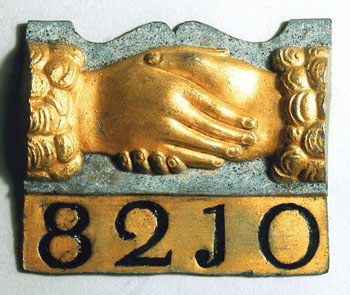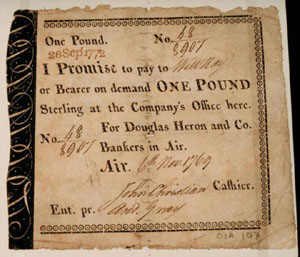Economic life was gradually becoming more organised. At the beginning of the eighteenth century ‘shops’ were what we would call ‘workshops’, or a rented booth. By the end of the century the modern ‘shop’ had evolved, a separate retail unit, gradually acquiring larger windows for showing what was for sale inside, and specialist interior fittings for storage and display.
Industries which needed space, or created noise or pollution, such as smithies, saw-pits and tanneries, were being encouraged to move away from town centres, leaving them clear for retail and office use. Most towns held markets and fairs, but dealing in animals began to be moved out of town centres to designated market sites, reducing the disruption and danger to the public.
£1 note, Douglas Heron
& Co, bankers in Ayr, 1769.
©
SCRAN/National Museums of Scotland
£1 note, Fife Banking
Company, Cupar.
© SCRAN/Aberdeen
City Council
The clearest symbol of change in economic
life in Scotland was the gradual development of a banking
network. The Bank of Scotland had been established
in Edinburgh in 1695, and the Royal Bank in 1727. The British Linen
Company, founded in 1746 to promote the linen industry, had developed
into a bank by the 1760s. There were also private banks, and a number
of provincial banks grew up, starting with the Aberdeen Banking Company
in 1747 and the Ship Bank in Glasgow the following year. By 1787 there
were banking companies in Dumfries, Dundee, Falkirk, Greenock, Paisley,
Perth and Stirling. By 1820 there were about thirty, but quickly thereafter
many collapsed or merged with national banks. Both national and provincial
banks developed branch networks, and the number of bank branches in
a town by the 1820s is a measure of the volume of economic activity.
Lead fire
mark, issued by the Friendly Society of Edinburgh. Marks such as this
were attached to buildings to show which insurance company had been paid
to protect them.
©
SCRAN/National Museums of Scotland

Most banks agencies were run by merchants or lawyers, from their own offices. Purpose-built banks with their distinctive architecture are a feature of the later nineteenth century, though there are a few earlier buildings. By the 1820s, however, there were in many provincial towns buildings which had been designed specifically as offices for writers (solicitors), who were often also agents for banks, and for the newly established insurance companies. These were mainly to protect against fire, and some towns had simple fire engines.

